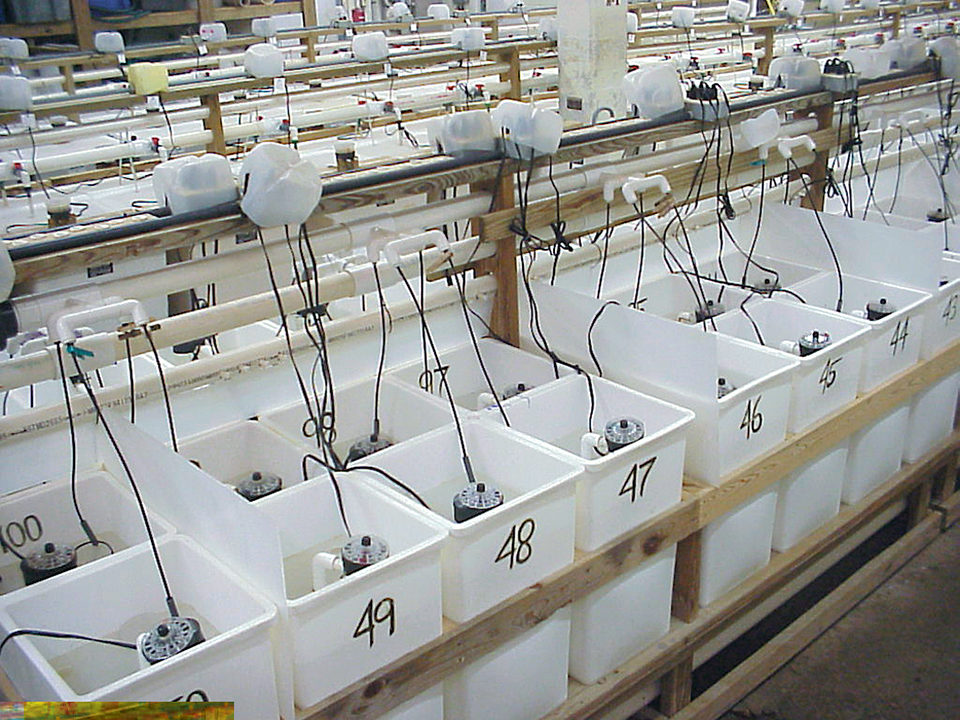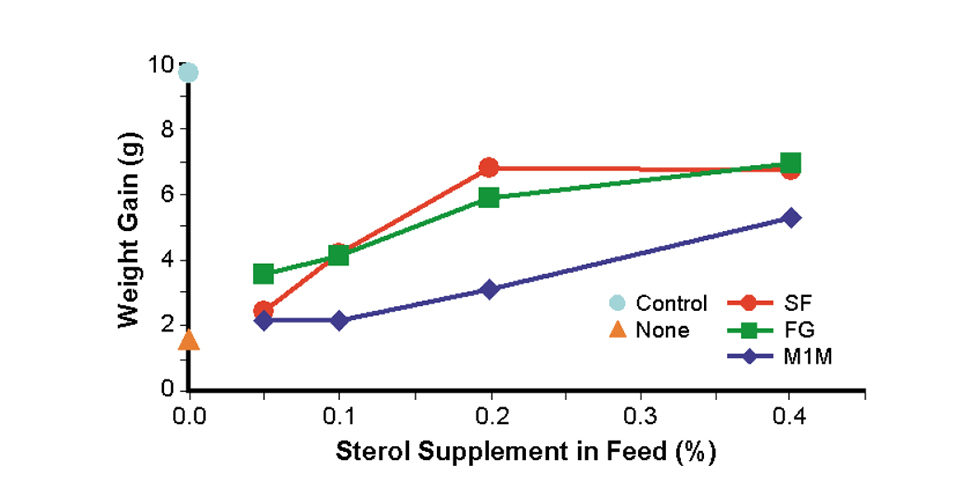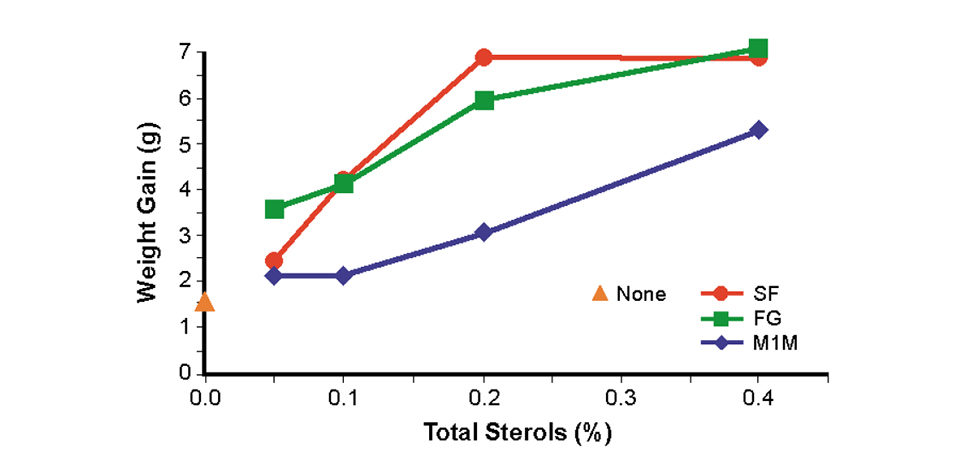Growth was greater than would have been expected on the basis of cholesterol alone

Cholesterol is an essential dietary nutrient in shrimp. Like other crustaceans, shrimp cannot synthesize cholesterol, so dietary cholesterol is necessary for the animals’ growth and survival.
The optimum dietary level depends upon the shrimp species, feed and growth rates, and presence of other nutrients. Under a variety of conditions, the cholesterol requirements for Pacific white shrimp (Litopenaeus vannamei) have been reported as 0.05 to 0.5 percent.
Dietary phospholipids can facilitate the utilization of cholesterol by crustaceans and decrease their requirement for cholesterol. In L. vannamei fed to excess, cholesterol levels for optimum growth have been reported as 0.35, 0.14, 0.13 and 0.05 percent at phospholipid levels of 0, 1.5, 3.0 and 5.0 percent, respectively (Gong et al., 2000).
Supplementation required
Although meals made from fish, shrimp, squid, crabs, and other animals containing cholesterol can provide a portion of the requirement for cholesterol in shrimp feeds, supplementation with purified cholesterol or other ingredients containing cholesterol is required to obtain optimum growth (Coutteau et al., 2002). However, cholesterol is a relatively expensive feed ingredient.
The apparent dietary requirement for cholesterol in crustaceans can potentially be satisfied by sterols other than cholesterol. The conversion of other sterols to cholesterol has been demonstrated in numerous crustaceans. However, the ability of other sterols to satisfy the cholesterol requirements for growth and survival is variable in crustaceans. Phytosterols, for example, are relatively ineffective as substitutes for cholesterol in shrimp (Teshima et al., 1989).
Cholesterol supplements
To compare cholesterol supplements with different cholesterol and sterol compositions, the authors conducted a growth trial with L. vannamei using two cholesterol supplements. Cholesterol SF was a purified cholesterol product that contained 91 percent or more cholesterol and was 97 percent or more sterols. Cholesterol FG was a less purified product that contained 60 percent or more cholesterol and was 75 percent or more sterols. The FG product was about 10 percent less expensive than cholesterol SF.
To demonstrate the contribution of sterols other than cholesterol, a third sterol mixture, sterols M1M, was compared to cholesterols SF and FG. M1M contained 21 percent cholesterol and 63 percent total sterols. The composition of sterols other than cholesterol in M1M was similar to that in cholesterol FG.
Experimental diets
Using purified and semipurified ingredients, experimental diets were formulated to contain five levels (0.00, 0.05, 0.10, 0.20 and 0.40 percent) of the supplements. In addition, a high-quality commercial feed was used as a control to compare the semipurified diets to a practical feed.
The diets formulations substituted the sterols for equal amounts of wheat starch. The primary protein sources were purified soy protein, casein, and wheat gluten. Krill meal was added at 2 percent as an attractant. To minimize the interaction between phospholipids and cholesterol, no supplemental phospholipid was added.
The diets were extruded at room temperature using carboxymethylcellulose as a binder. Proximate analysis of the experimental diets was 35.5 percent protein, 6.0 percent lipid, 8.2 percent ash and 4 percent fiber.
Levels of cholesterol and total sterols in the feeds were calculated for each diet from the level of cholesterol in the base diet, the amount of sterol supplement in the diet, and the amounts of cholesterol and total sterols in the supplements (Table 1). Analyzed levels of cholesterol and proximate analysis constituents in the experimental feeds closely agreed with the calculated levels.
Castille, Cholesterol and total sterol levels, Table 1
| Supplement Level (%) | Cholesterol SF | Cholesterol FG | Cholesterol M1M | Total Sterols SF | Total Sterols FG | Total Sterols M1M |
|---|---|---|---|---|---|---|
| 0.00 | 0.02* | 0.02* | ||||
| 0.05 | 0.07 | 0.05 | 0.03 | 0.07 | 0.06 | 0.05 |
| 0.10 | 0.11 | 0.09 | 0.04 | 0.12 | 0.11 | 0.08 |
| 0.20 | 0.22 | 0.15 | 0.06 | 0.22 | 0.19 | 0.15 |
| 0.40 | 0.35 | 0.29 | 0.10 | 0.41 | 0.36 | 0.27 |
Growth trial
In a 57-day growth trial, shrimp with an average weight of 0.21 grams were stocked at a density of four shrimp per 30 liter tank. Heated, filtered sea water was recirculated through the tanks to remove uneaten feed and insure high water quality. Approximately 9 to 12 percent of the sea water was replaced daily. Salinity was maintained at 25 to 26 ppt, with temperature at 30 to 32 degrees-C.
Shrimp were fed 15 times daily with automatic feeders at a rate in excess of consumption. During the trial, temperature, dissolved oxygen, and salinity were measured daily. Ammonia, nitrite, nitrate, and pH were measured weekly. All water quality parameters were adequate for good growth and survival.
Survival
For the experimental diets, survival ranged from 64 percent for the diet without sterol supplementation to 91 percent for the diet with 0.4 percent cholesterol FG. Survival for shrimp on the control diet was 94 percent.
Growth
The effects of type and level of sterol supplement on growth are summarized in Fig. 1. With the semipurified, experimental diets, weight gains ranged from 1.6 grams for the diet without sterol supplements to 7.0 grams for the diet with 0.4 percent cholesterol FG. Weight gain for the control was 9.7 grams.

For the experimental diets, there was an interaction between type and level of sterol supplement. For the 0.05 percent level, growth on FG was greater than on M1M. For the 0.1 to 0.4 percent levels, growth on both SF and FG was greater than on M1M, but the differences between SF and FG were small.
In general, growth increased with level of sterol. However, for SF, growth did not increase above 0.2 percent, and for FG and M1M, growth did not decrease below 0.1 percent. The results suggested that the requirement for cholesterol SF to give optimum growth was 0.16 percent and 0.25 percent for cholesterol FG.
The effects of cholesterol in the diets on growth are shown in Fig. 2. The cholesterol SF data indicated that the requirement for cholesterol was 0.15 percent under the conditions of the trial. The growth values for cholesterol FG and sterols M1M were above that for cholesterol SF. This suggested that growth was greater than would have been expected on the basis of cholesterol alone, and that the sterols other than cholesterol in cholesterol FG and sterols M1M contributed to the increased growth.

The effects on growth of total sterols in the diets is shown in Fig. 3. In contrast to the effects of cholesterol in the preceding figure, the growth response for sterols M1M was lower than the value generated for cholesterol SF, which suggested that the sterols in M1M were not as effective as the predominately cholesterol sterols in cholesterol SG.

Note: Cited references are available from the first author.
(Editor’s Note: This article was originally published in the April 2005 print edition of the Global Aquaculture Advocate.)
Now that you've finished reading the article ...
… we hope you’ll consider supporting our mission to document the evolution of the global aquaculture industry and share our vast network of contributors’ expansive knowledge every week.
By becoming a Global Seafood Alliance member, you’re ensuring that all of the pre-competitive work we do through member benefits, resources and events can continue. Individual membership costs just $50 a year. GSA individual and corporate members receive complimentary access to a series of GOAL virtual events beginning in April. Join now.
Not a GSA member? Join us.
Authors
-
Frank Castille, Ph.D.
TAES Shrimp Mariculture Research
1300 Port Street
Port Aransas, Texas 78373 USA[109,111,99,46,111,111,104,97,121,64,99,108,102,112,109,115]
-
Addison Lawrence, Ph.D.
TAES Shrimp Mariculture Research
1300 Port Street
Port Aransas, Texas 78373 USA -
Peter Buisman
Solvay Pharmaceuticals
Weesp, The Netherlands -
Rien Drost
Solvay Pharmaceuticals
Weesp, The Netherlands
Tagged With
Related Posts

Aquafeeds
Animal byproducts can provide cholesterol for shrimp feed
Animal byproducts like blood meal, meat and bone meal and other rendered products are good sources of cholesterol for use in aquaculture feed.

Health & Welfare
Digestibility enhancer can offset cholesterol content in shrimp feed
Cholesterol is an essential nutrient for penaeid shrimp. Trials found that a digestibility enhancer based on natural emulsifiers was as effective as purified cholesterol in improving shrimp growth and feed conversion.

Intelligence
Facts about shrimp and cholesterol
Many people, including health-conscious consumers, are concerned about the cholesterol content of foods such as meat, eggs and dairy products. In the case of shrimp, the cholesterol story is different because a number of research studies have demonstrated that the high percentage of “good fats” in shrimp reduce the impact of cholesterol, and that a majority of people can eat shrimp as part of a balanced diet.

Aquafeeds
A look at phospholipids in aquafeeds
Phospholipids are the major constituents of cell membranes and are vital to the normal function of every cell and organ. The inclusion of phospholipids in aquafeeds ensures increased growth, better survival and stress resistance, and prevention of skeletal deformities of larval and juvenile stages of fish and shellfish species.


